#Christine Westrich
Photo
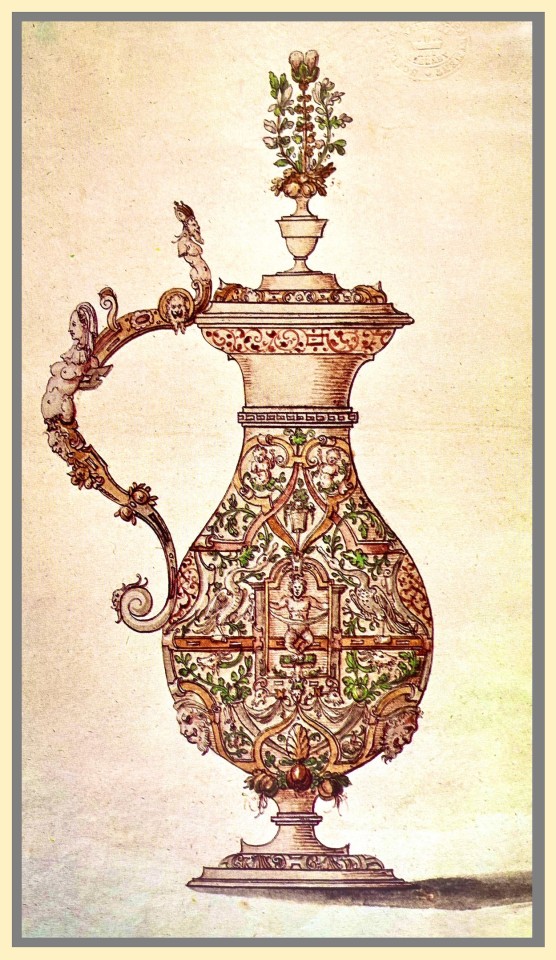

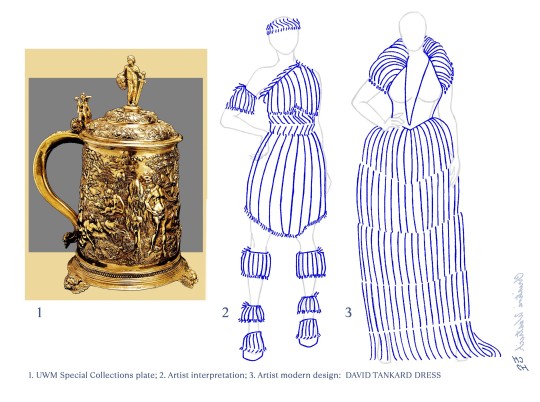

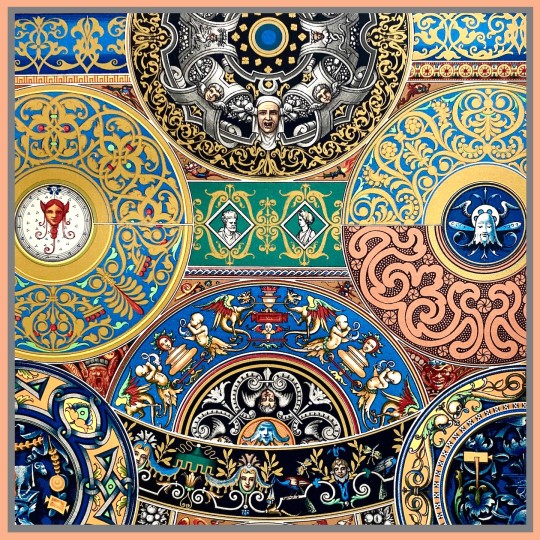


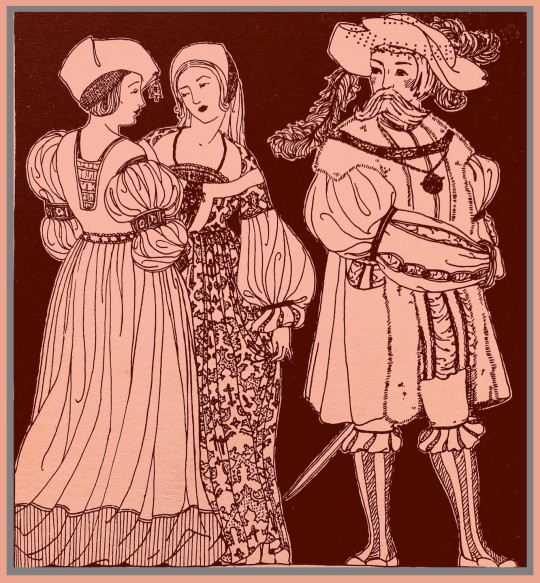

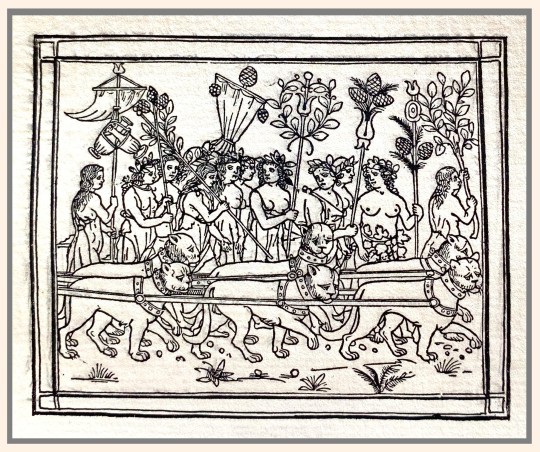
Fashion Friday: The Mannerism of Michelangelo
The Renaissance period is often synonymous with the greats of Michelangelo, Da Vinci, and young Raphael. These master painters poised "imitation" as preeminent beauty, art as poetry—ut pictura poesis—with Michelangelo arguably harnessing the peculiarities of the human spirit most adeptly in his abstract sprawl of figures, elongating their unseen beauty.
A Renaissance essay on Michelangelo by the nineteenth century art critic Walter Horatio Pater investigates the imagination of the master, calling attention to the artist's wayward loves-at-first-sight and their contradictions with the sculptor's mantra of la dove io t'amai prima, or, where I loved you before. Pater argues that it is precisely this paradox that comprises harmony: the delight between the sweet and the strange.
Pater repudiated his own time of the Victorian era, acclaiming the decadence of the Renaissance period as the seizing of life, or more aptly in his own words on living:
...to grasp at any exquisite passion... or any stirring of the senses, strange dyes, strange colours, and curious odours, or the work of the artist's hands, or the face one's friend.
It is in his words that we can embrace the unnatural grace of the late Renaissance, the period adorned with the Mannerist style of bold outlines, objects at-play with nature, and form with fantastical animal-humans. This unique style of the Renaissance is attributed to Michelangelo's successors who desperately tried to imitate his alien elegance.
Hidden in the figures of Michelangelo are these languid features, satyrs in repose, where solemnity and "faces charged with dreams" dictate, as described by Pater. Darting poetic thoughts give us a glimpse of the bittersweet temperament of Michelangelo's genius. He wrote of his torments in the pagan frivolities of endless quarrelling and his anger at the Gods for loving him so that he reached an age of eighty-eight years.
In all of his years, Michelangelo claimed his figures to be common, austere persons, yet his hand rendered an inherent surprise and energy that future imitators would exploit in quirky forest gods and lovely monsters.
Ergo, my first fashion plate is titled "DRAGON EWER Dress," odd, but not as eccentric as the last two designs; perhaps you can trace the growth of the outlandish creature in each iteration.
Here is a listing of sources from the UWM Special Collections which I have augmented with digital color and outline to emphasize particular details of my inspiration:
1) A watercolor drawing by (or after) Wenzel Jamnitzer, circa 1575 in the Virtuoso Goldsmiths and the Triumph of Mannerism, published by Rizzoli International in 1976.
2-4) My interpretation and contemporary design of the DRAGON EWER Dress, SNAIL CUP Dress and DAVID TANKARD Dress based on Renaissance period vessels between 1540 to 1590 as published in the Virtuoso Goldsmiths and the Triumph of Mannerism, published by Rizzoli International, in 1976.
5, 6) French Renaissance plates of frieze borders in Rouen prayer books from 1508; and painted enamel work of Limoges under Italian faience between 1520 and 1540 as published in the Das polychrome Ornament: Hundert Tafeln, by P. Neff in 1880.
7) Walter Pater included an image of Michelangelo's The Holy Family, or, Doni Madonna, at the Uffizi in Florence, Italy in his aethesticism manifesto, The Renaissance: Studies in Art and Poetry, published by the Limited Editions Club, Stamperia Valdonega in 1976.
8) Costume of the early sixteenth century often in velvets (red is common) and embellished with fewels, gold, lace, fur and feathers as illustrated by Belle Northrup in A Short Description of Historic Fashion published by the Teachers College at in 1925.
9) An 1592 engraving by Joseph Boillot titled Et Levrs Antipatie (possible translation Antipathy Lips) as published The Renaissance in France: Illustrated Books from the Department of Printing and Graphic Arts, by the Houghton Library, Harvard University in 1995.
10) A drawing or possible woodcut of indentured lions as published in Thomas Wood Stevens' Book of Words: A Pageant of the Italian Renaissance, published by the Alderbrink Press at the Art Institute Chicago in 1909 for the Antiquarian Society.
View my other posts on historical fashion research in Special Collections.
View more Fashion posts.
—Christine Westrich, MFA Graduate Student in Intermedia Arts
#Fashion Friday#graduate research#Christine Westrich#Renaissance#Renaissance fashion#fashion#costumes#costume design#fashion design#fashion plates#Michelangelo#Walter Horatio Pater#Virtuoso Goldsmiths and the Triumph of Mannerism#Das polychrome Ornament#The Renaissance: Studies in Art and Poetry#A Short Description of Historic Fashion#The Renaissance in France#Book of words; a pageant of the Italian renaissance
92 notes
·
View notes
Photo


Christine Westrich, contemporary designs of Estonian Edith and Czech Crown dress based on illustrations in Parishes of Estonia 2010 (AS Regio, 2010) and Folklore Map of Czechoslovakia (Ministerstvo Informaci, Czechoslovakia, 1948). See more
0 notes
Photo




Christine Westrich (BFA 12 Illustration)
If you want cool, you've come to the right place, the office occupied by Milwaukee County Emergency Management Director Christine Westrich.
U.S. Naval Academy graduate, former Marine, broke barriers by taking the back seat in an F/A-18D Hornet, worked at the White House and the Pentagon, did some consulting, made a big life switch by going off to art school (at ArtCenter College of Design) in California, and now she's back home.
How she got here is a long life story, wedged into 44 years.
But know this: If there is ever an emergency, Westrich has your back.
Like the time she and a pilot were in an air combat exercise with an opponent over the Atlantic Ocean off Beaufort, S.C. The pilot lost control of the jet and suddenly they were dropping and swinging down to the water. As the pilot struggled to regain control, Westrich calmly relayed the altitude figures. Down they went.
The jet flipped upside down, then right side up.
"It's like a living being," she said. " 'Come on, recover.' It just has to catch the right air, the right attitude. We were like a rock torpedoing to the Atlantic Ocean."
They were still falling, below ejection level, and she kept reading the numbers.
Finally, the jet recovered.
They landed. Got back to the squad room and someone casually mentioned something about an afternoon flight.
"It was clear we're going to go back to fly," Westrich said.
And up they went.
By comparison, running Milwaukee County's emergency management department is a bureaucratic job of planning and execution. It pays $120,000 annually. Westrich oversees 65 full-time employees.
Her department is an umbrella for the 911 operations center, emergency medical services, radio services and emergency management.
According to its mission, the office is in "the business of urban resiliency..."
County Executive Chris Abele said Westrich is among several military veterans in leadership positions in county government.
"What they all have in common is they are very comfortable with and respectful of accountability and respect of government. It's not a game and they take it seriously. They all have a can-do attitude," he said.
"The first time I saw Christine's résumé I thought, 'I can't believe I have an opportunity to hire you. It's pretty impressive,' " Abele said. "She has a really good way to build consensus. I've watched as she has earned the respect of mayors and village presidents around the area. She's frank, she's earnest, she's clear. I know because I work with her. She genuinely cares about public service."
Meet Westrich and you notice her tattoos, what she calls skin art.
On her left hand is a stained glass window design from Frank Lloyd Wright's Susan Lawrence Dana House. Up her left forearm is an image of Dutch artist Johannes Vermeer's "The Lacemaker." And on her right wrist and arm is a classic "Windrush" replica from English designer William Morris.
"They remind me to maintain a creative attitude," Westrich said.
A 1990 graduate of Waukesha South High School, Westrich had the grades, the drive and a push in the right direction from her aunt to get into the Naval Academy in Annapolis, Md. In college, she ran track, studied and got a degree in ocean engineering.
She said she didn't have an ambition to "break the glass ceiling." Instead, she was "driven by transcending stereotypes." As she focused on whether to vie for a Navy or Marine Corps officer commission, she said that at the Naval Academy in that era she did not recall seeing any women Marine Corps officers.
"I thought, 'Can you be a woman and a Marine Corps officer? Can you do both?' I thought, 'Well, I'm going to try.' "
She set her sights on Marine Corps aviation. From July 1998 to January 2001, Westrich was a F/A-18D Hornet weapons system operator.
"I was a navigator, just like Goose in 'Top Gun,' " she said with a smile, recalling the 1986 film.
Steve Ganyard was her squadron commander and lauded Westrich as a ground-breaker, among the first two women to fill the weapons system operator position in the Marines. She also became the first female air combat tactics instructor in the Corps.
"Being the first woman in a fighter ready room was fraught with potential danger," Ganyard said. "Probably because of her Naval Academy background she handled any challenges based on her sex with flair and good humor. She was in every good sense of the term one of the boys."
Westrich's call sign was "Mulan," after the Walt Disney film.
"The warrior princess fit her well," Ganyard said.
About halfway through her assignment, Westrich discovered that she didn't meet the minimum weight for the F-18's ejection seat, which was designed for men. The upshot: she stood a significant chance of being killed or seriously injured if she had to eject.
"We had a closed-door chat," Ganyard said. "I said if I were your father, I'd tell you that you need to stop flying. But as your commanding officer, I'm going to leave it up to you."
Westrich kept flying. But eventually, she gave it up, fearing that her situation could jeopardize pilots.
She later was assigned to U.S. Naval intelligence as an air defense analyst, worked in the White House as a liaison to the president's and vice president's military aides and did a stint at the Pentagon working for the secretary of defense. All of her work was the highest degree of classification.
Westrich left the military in 2006 and worked for nearly four years as a defense contractor.
But she found herself pulled in another direction. The passion for art ran in her family. While in the military, she designed squadron T-shirts and painted murals. But she wanted to go deeper into the subject and eventually enrolled at the ArtCenter College of Design in Pasadena, Calif., where she earned a bachelor's of fine arts degree.
"I like academics. I wanted formal training," she said. "Let me have the experience and see where this takes me."
Her student work was heavy on illustrations, where she told stories through pencil drawings and oil paintings. She also branched out to hand embroidery. In one unique item, she embroidered a nude self-portrait tucked inside her flight officer's jacket. Recently, she painted a portrait of Gary Wetzel, a Medal of Honor recipient from Oak Creek.
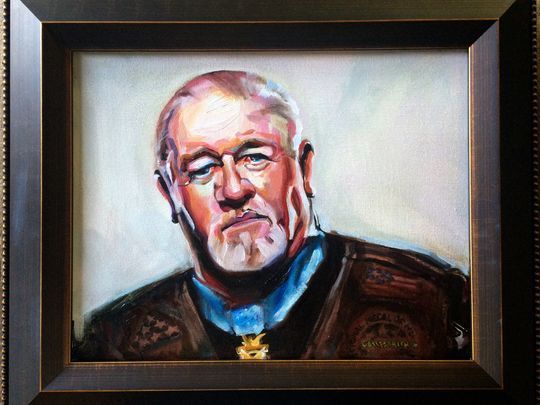
For Westrich, art is a way to leave a mark.
With her degree in hand, she returned to Milwaukee, where her twin brother, older brother and sister live. Her parents are deceased.
She landed a job with Milwaukee County in July 2013, just in time to help rewrite the government's continuity of operations program in the wake of the courthouse fire that cost $19.1 million in damages.
In 2015, four previously independent divisions were combined to create the emergency management department. Westrich became director. She even designed the logo.
"We're in a really good place right now," she said. "I'd say we're pretty steady, still making a lot of changes. Doing anything new in county government really takes that type of heavy lifting."
The aim is to be prepared and make sure that whatever the emergency, the county can carry on.
The article originally appeared in the Journal Sentinel.
0 notes
Photo

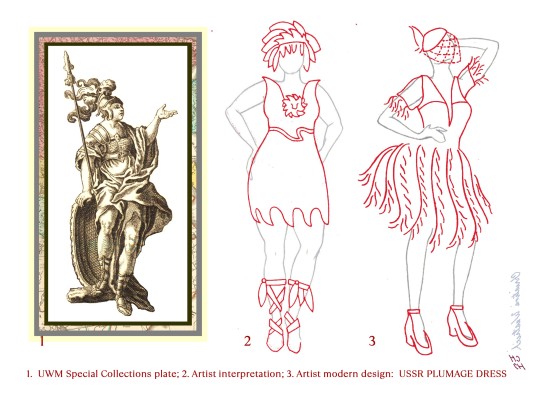
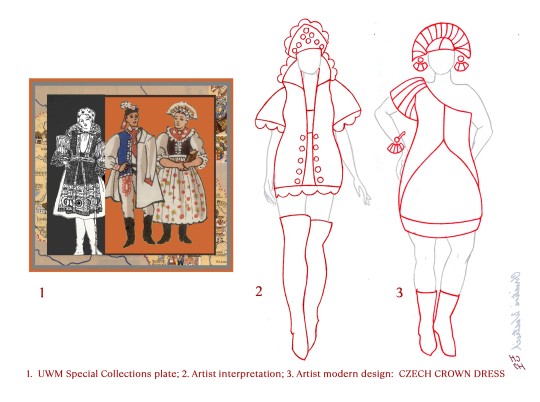
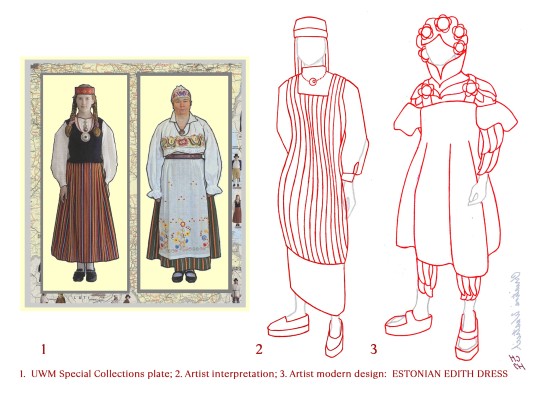

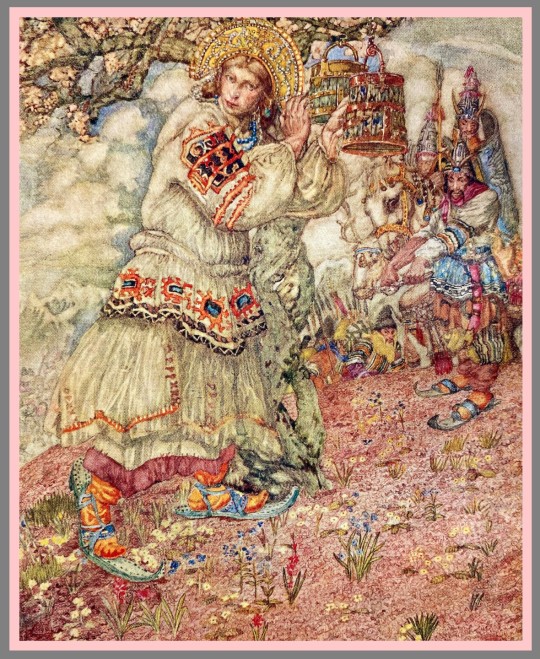


Fashion Friday: The Power of Plumage
The dissolution of the Soviet Union in 1991 resulted in the creation of fifteen nation-states including Ukraine and Estonia, while 1993 saw the end of communist rule in Czechoslovakia, becoming the Czech Republic and Slovakia. These nations are featured here in my second-to-last fashion plate post with costumes honoring easier days of traditional ethnic dress.
Leo Tolstoy could be argued as the conscience of Russian peasants by his fictional writing in the classic Anna Karenina. Tolstoy was in fact a nobleman and landowner yet he adorned himself in smocks and meager dress, fashioning humility as he wrote of earthly indulgences and subtle sermons on the wickedness of the human condition.
The dress of laborers is also honored in a 1936 Soviet Union publication on a revered textile worker in Miss USSR where a young woman's 10-hour days and record-breaking statistics on factory looms are lauded as joyful. Her uniform is a black silk blouse and skirt and her profile is documented as "slim" and "little."
Yet, as with the earliest civilizations there is a place for costume, for adornment that celebrates more than the work of our hands or size of our bodies, whether a farmer's, a writer's, or a weaver's; we yearn for the occasion allowing ornamentation that arouses our senses and inflames our imaginations.
My first fashion plate is titled the USSR Plume Dress, perhaps interpreted by some as a peacock's egoism; the second plate may be favored by fan-followers of Egon Schiele, while the last crowns brawn and might.
Here is a listing of sources from the UWM Special Collections and the UWM American Geographical Society Library that I have augmented with digital color and outline to emphasize particular details of my inspiration:
1, 8) Wood-engravings by Nikolas Piskariov as featured in Leo Tolstoy's Anna Karenina; published in the USSR in 1933 and printed by the Limited Editions Club, respectively titled Anna's Fall and Head-Piece to Part the Fifth.
2-4) My contemporary designs of the USSR Plume Dress, Estonian Edith Dress, and Czech Crown Dress based on maps from the collection of the UWM American Geographical Society Library that show iconic costumes, respectively titled Russian Empire 1757, published in Augsburg, GE by Augustae Vindel in 1757; Folklore Map of Czechoslovakia, published in Czechoslovakia by the Ministerstvo Informaci in 1948; Parishes of Estonia 2010, published by the AS Regio in 2010.
3) Black and white drawing of Czechoslovakian dress by Belle Northrup in A Short Description of Historic Fashion published by Columbia University's Teachers College in 1925.
5) Photograph of Dusya Vinogradovo a 21-year old woman dubbed Miss USSR: The Story of a Girl Stakhanovite, the Soviet Union's leader in weaving production and noted to be every young person's friend as she was "free and happy"; published in New York by International Publishers in 1936.
6, 7) Illustrations by Noel L. Nisbet from the collection of Russian Cossack Fairy Tales and Folk Tales, published in London by George G. Harrap & CO in 1916, respectively titled They Came to the Place Where He Had Left Her and His Wife Caressed and Wheedled Him.
View my other posts on historical fashion research in Special Collections.
View more Fashion Friday posts.
—Christine Westrich, MFA Graduate Student in Intermedia Arts
#Fashion Friday#graduate research#Christine Westrich#fashion plates#costume design#fashion design#Eastern Europe#leo tolstoy#Anna Karenina#Russian costumes#Czechoslovakian costumes#Estonian costumes#A Short Description of Historic Fashion#Miss USSR#Cossack Fairy Tales and Folk Tales
55 notes
·
View notes
Photo
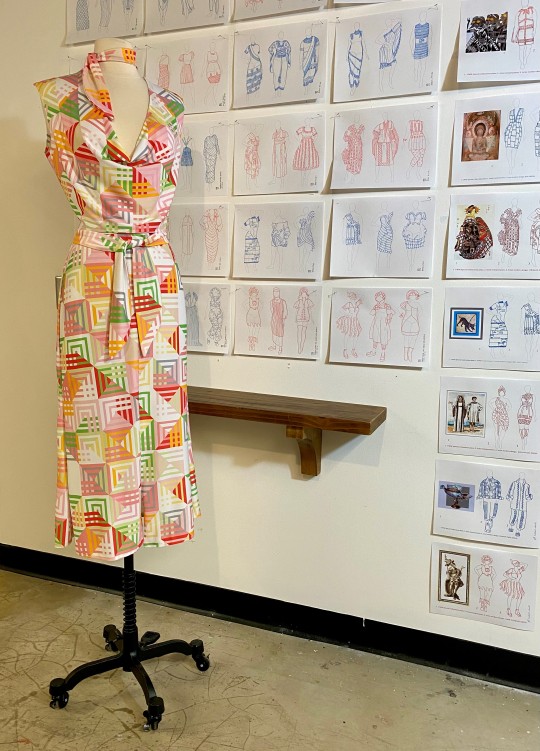



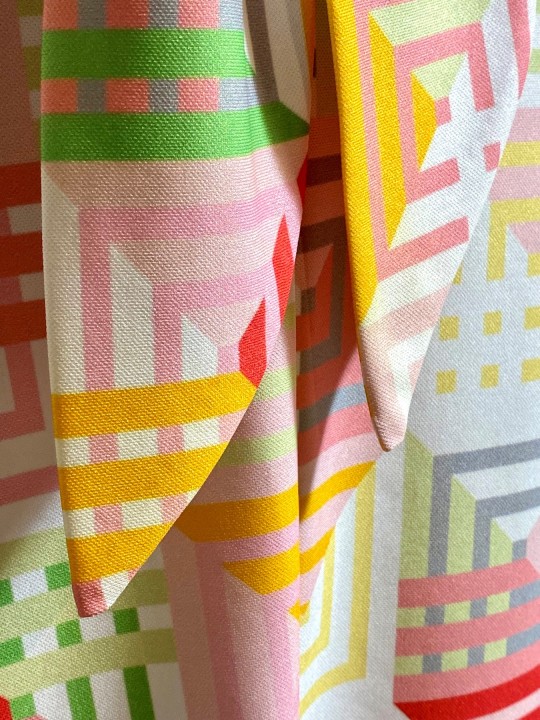

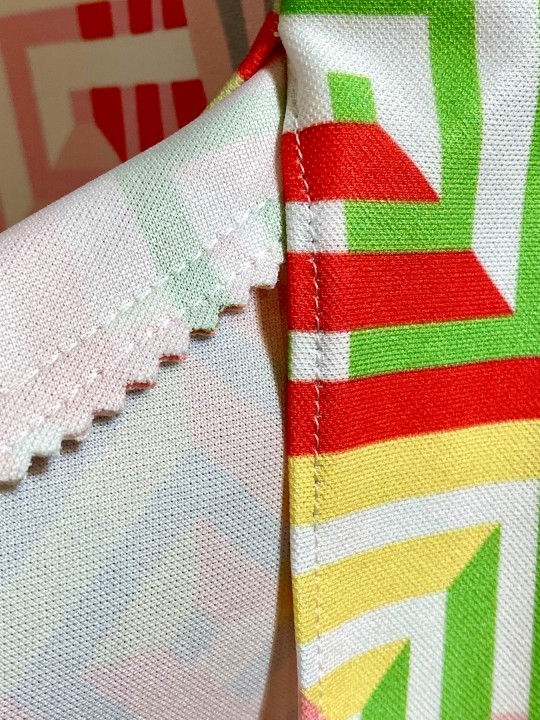


An End-of-the-Semester Fashion Friday Finale
MFA graduate student Christine Westrich spent the spring 2022 semester conducting an independent study in UWM Special Collections researching historical costume styles as a basis for creating her own contemporary fashion designs. Her diligent work in identifying and reviewing our resources resulted in dozens of original designs, which she blogged about on our Tumblr site every week. Her official study has now concluded, and she made her final post about her work last week.
Christine was a joy to work with, and we are delighted to have had the opportunity to help facilitate and guide her research. Now it is time for actual costumes to be made manifest from her designs, and Christine is beginning that process. Her first dress was made not only from her original design but also from patterned fabric of her design. It was completed, or is near completion under her fashion label, CHCH. The dress is shown here against all the patterns she completed this semester, along with details of the finishes. This CHCH dress bears a likeness to the Egyptian Necklace Dress she designed earlier this semester (also shown here). The main differences are sleeveless rather than fluttering sleeves, center slit rather than side slit, and waist & necktie rather than jewels. Her original fabric pattern is called "Gorgeous," and its colorful grid pattern required making these modifications.
Christine also conducted a parallel independent study this semester with Senior Lecturer in Costume Design Kathleen Donnelly in the UWM Theatre Department. Also shown here is an embroidered design Christine produced for an apron used in the spring UWM production of Stephen Sondheim‘s musical Into the Woods.
Congratulations Christine on an engaging and productive spring semester!
View all ten of Christine Westrich’s posts on historical fashion research in Special Collections.
View more Fashion Friday posts.
45 notes
·
View notes
Photo

Fashion Friday: Sixty Drawings of Haute Couture
The is the final post by Intermedia Arts MFA student Christine Westrich who spent the the entire Spring 2022 semester mining the primary resources of Special Collections and the American Geographical Society Library as inspirations for creating new fashion designs. It has been a rich and engaging experience. Here are Christine’s culminating observations:
Haute couture never fails to impress on Anna Wintour's red carpet of the Met Gala. Just a few days ago, the Spring 2022 theme of Gilded Glamour posed a great atelier challenge: to dress in themed opulence or to curb the nines in restraint of today's pandemic/war/climate calamities?
A breeze through the runway photos show that Instagram won the day with celebrities donning nothing short of costume ecstasy with Billie Eilish's feathered décolleté by Gucci and Megan Thee Stallion's winged caplets by Moschino. Lizzo's wondrous caftan by Thom Browne brings thoughts to the late André Leon Talley, the lovely protege of Diana Vreeland and the man behind Vogue elegance.
These styles are orchestrated for their line, shape, and color. While ostentatious, they are cleverly choreographed for the camera. The monochromatic pinks of Valentino and unfussed Tom Ford silhouettes give homage to the sculpturist images of Robert Mapplethorpe who often chided his muse Patti Smith to deconstruct her flair so he could capture a timeless polaroid.
Whether the dress statement of Mayor Eric Adams to end gun violence in the wake of the NYC subway shootings, or Hillary Clinton's ode to Clara Barton and Harriet Tubman, clothing is a means to influence, to power, a means of manipulation as described by John Berger in 1972.
Over this Spring term, I completed sixty fashion drawings under my design moniker "chch", which arouse just such drama; the dominance and brawn of past civilizations inspired in illustrative gowns for our modern era. From Egyptian gods to Middle Age saints to pre-common-era princes, these designs challenged my thoughts on the exploitation of dress.
Daily, we face the decision of what to wear, considering how we may look walking to Colectivo, sitting on a work stool or looking back to an admirer. These choices reveal our inner playwright and expose us on life's stage of these non-quarantine days... coquettish, audacious, or perhaps hiding in plain sight.
And should such an extraordinary Met Gala invitation arrive on my doorstep, I would gladly construct one of my sixty costumes to wear and proudly compete in its outsider aesthetic against the pomp of a Milan fashion Maison. Of course, some days it feels best to give up on this visual communication problem of couture, of being under the lights—and in this case—I find my authentic self by joining society via the old-fashioned telephone.
A very special thanks to Senior Lecturer Kathleen Donnelly who provided me with expert costume construction know-how while emphasizing stage awareness and no-nonsense grit, both earned through years of theatre productions.
Thank you to the UWM Head of Special Collections Max Yela for his impeccable fashion taste and to Special Collections Department Manger Alice Ladrick for her kindred conversation on all things Milwaukee.
View my previous ten posts on historical fashion research in Special Collections.
View more Special Collections' Fashion posts.
—Christine Westrich, MFA Graduate Student in Intermedia Arts
21 notes
·
View notes
Photo
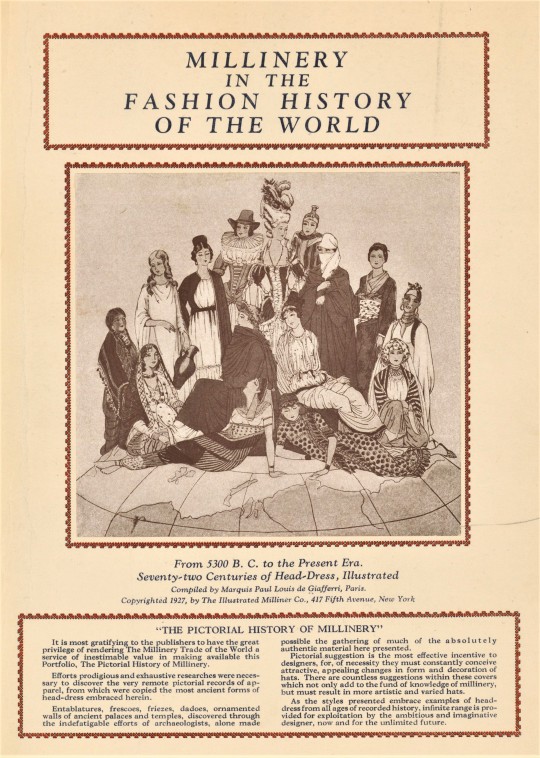

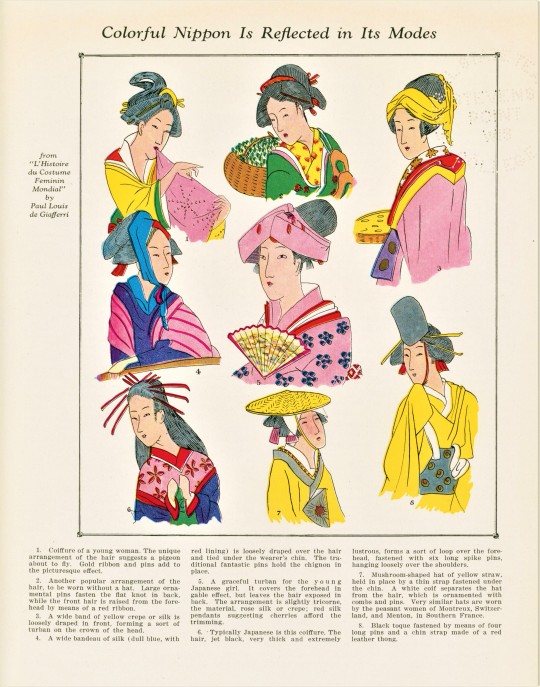
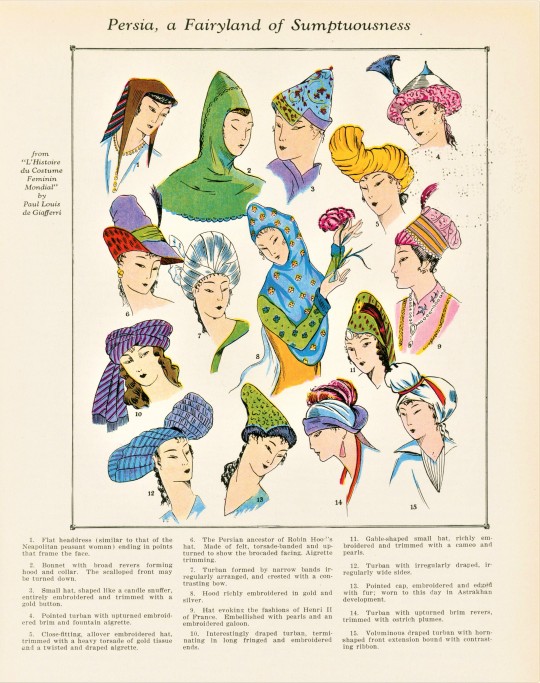
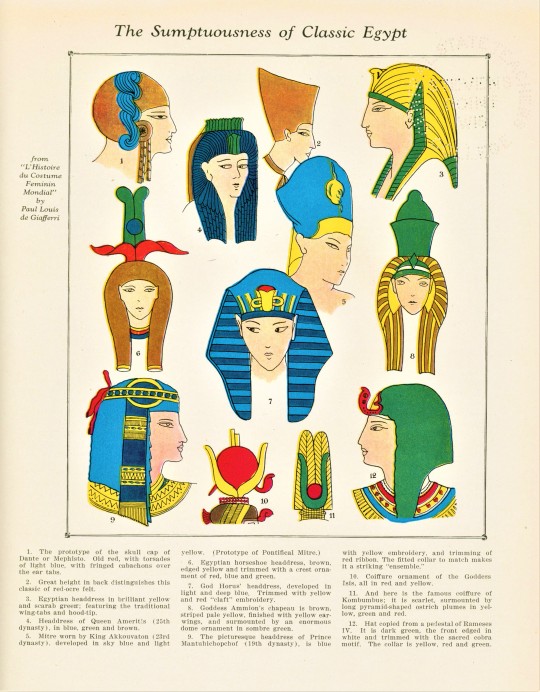
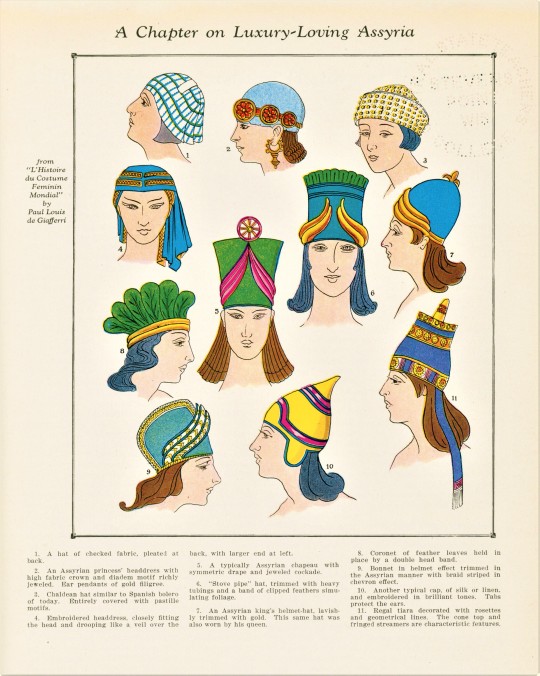
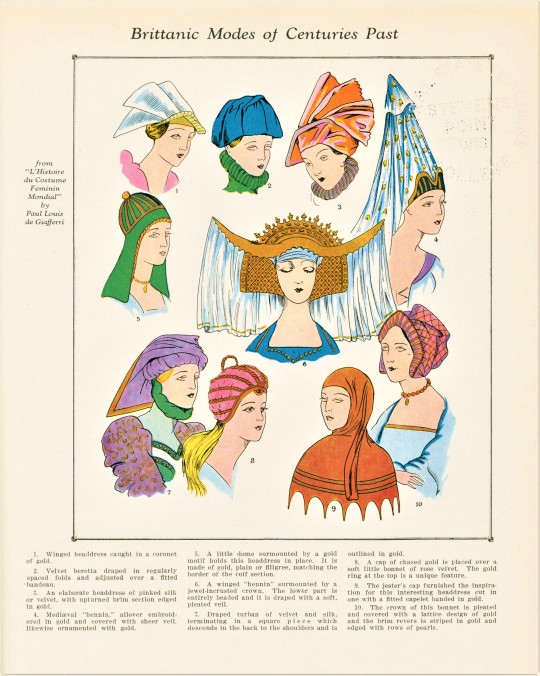



Fashion Friday Hat Mania!
We’re back to our regular Fashion Friday programming after this semester’s takeover by UWM MFA Graduate Student in Intermedia Arts, Christine Westrich. It has been a treat to see her perspective on our collection these last few months.
This week, we present plates from Millinery in the Fashion History of the World, by Paul Louis de Giafferri, originally published in segments from September of 1927 - December of 1928 in The Illustrated Milliner, a monthly magazine published in New York in the early 20th century by a publishing company of the same name. The monthly entries were later brought together into a set. Based on the cover (the first image above), it appears the plates were first published loosely in portfolio by The Illustrated Milliner and later bound, perhaps by The Central State Teacher’s College (now UW Steven’s Point), whose ownership stamp faintly marks each upper right corner. I borrowed this work from UW Steven’s Point Library after becoming intrigued by Giafferi’s work.
The plates themselves are reprinted from Giafferri’s L’histoire du Costume Féminin Mondial, (which we do hold here in Special Collections) with text condensed and translated from the original French, originally published in a series of portfolios by Éditions Nilsson of Paris, most likely from 1926-1927. The headings are additions for the American printing. It was also interesting to see some of the liberties the unidentified translator took with the descriptions on the plates. For example, #10 from the “New World Modes” plate reads:
The Illustrated Milliner: The prototype of Uncle Sam’s hat, made of beaver or silk plush and trimmed with a torsade of ribbon in two contrasting colors or tones.
L’histoire du Costume Féminin Mondial: Calotte haute, bords relevés d’un côté et abaissés de l’autre, avec torsade de deux tons de rubans au bas de la calotte. (A high cap, brim raised on one side and lowered on the other, with a twist of two-toned ribbons at the base of the cap)
To find out more about Giafferri and Éditions Nilsson, check out our previous posts on Giafferri’s works here.
View more Fashion Friday posts here.
And finally, you can find Christine’s creative take on our collection here.
-Olivia, Special Collections Graduate Intern
#Fashion Friday#Millinery in the Fashion History of the World#paul louis de giafferri#Giafferri#The Illustrated Milliner#Millinery#hats#chapeaux#L'histoire du costume Féminin Mondial#Éditions Nilsson#olivia
34 notes
·
View notes
Photo
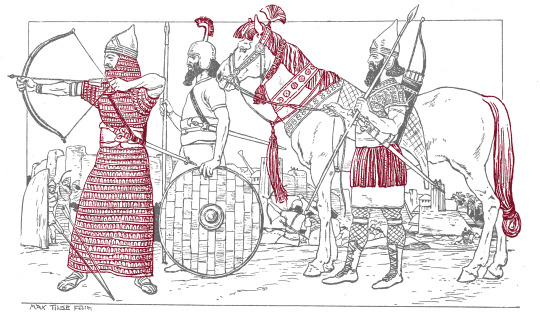



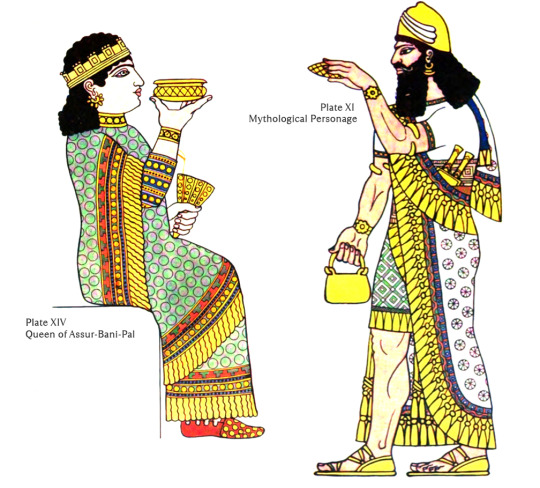
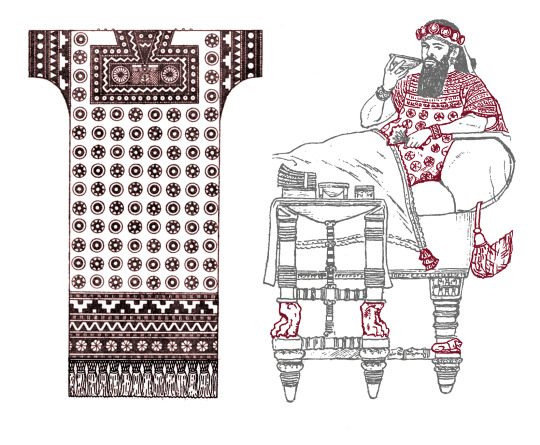
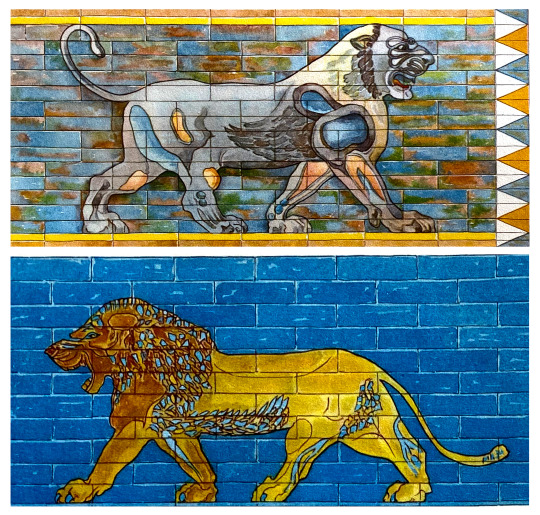

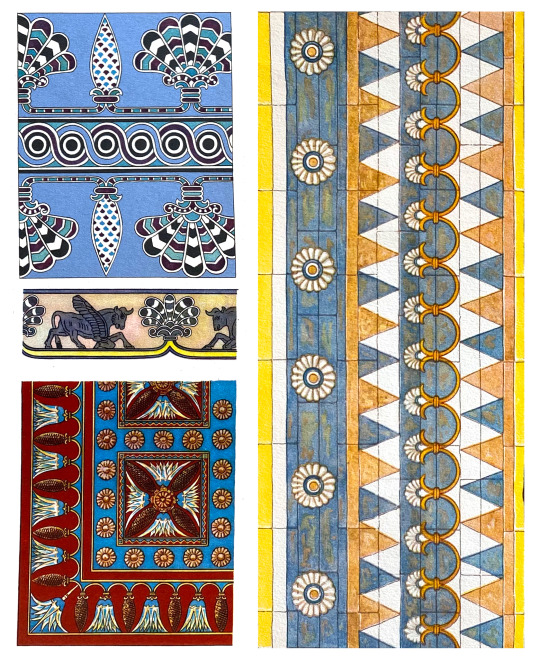
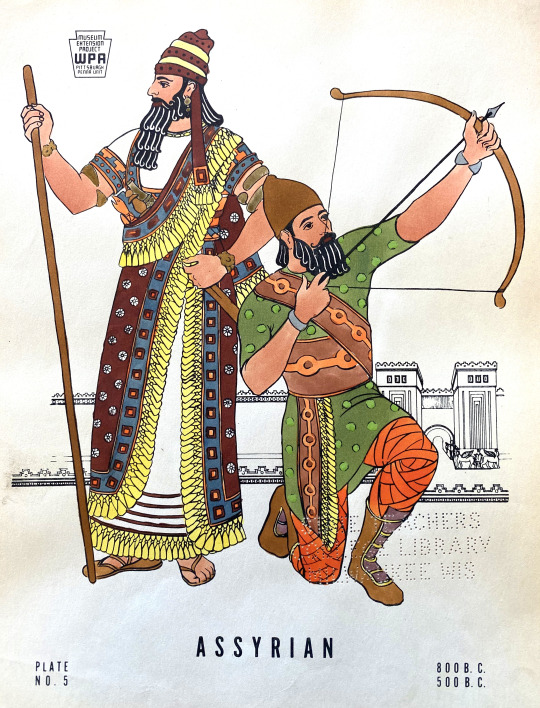
Fashion Friday: The Fringe Binge
Today, I continue my UWM Special Collections exploration of fashion through the ages with Assyrian costume. You may recall from last week’s post that I am conducting an independent study in Special Collections this semester on the history of costume and fashion to help inform my own practice.
The ornamentation of this ninth-century BCE culture is dramatic with complex layering, repeating patterns, and textile borders, e.g., dual beltings, rosettes, and lots of tassels. Sensibilities include shawls and slings, scaling armor, and animal fur, all invoking a fringe motif.
A significant source of Assyrian wearables are from one particular excavation site known as Sam'al or Zincirli in southern Turkey, its rulers changing over its 2,500 yearlong existence as a trading hub and crossroads of multicultural peoples. The buried fortress and the kingdom itself ended in the Neo-Assyrian period of the late seventh century BCE.
Among the prizes of this modern-day dig are two depictions of the lion: a formidable threat often shown in defeat in the King's hunt, and the lion as a hybrid deity—the lamassu— protecting the venerated empire.
My first fashion plate is inspired by an ancient fragment with rosette and fringe detail on both figures’ shawls and tunics, while the man's tarbush also has rosette and tassel. Can you spot the decorative muses in the additional plates?
Here is a listing of sources for my designs and featured plates:
1) Assyrian warriors from Geschichte des Kostums, published in New York by E. Weyhe, circa 1905.
2-3) My interpretation and contemporary design of the FIN and FRINGE DRESS inspired by "Caldeo-Assiro" plates VI and VII from volume one of Gli Stili Nella Forma e nel Colore, Rassegna dell’ Arte Antica e Moderna di Tutti i Paesi published in Torino by C. Crudo & Co. in 1925.
4) My interpretation and contemporary design of the FROCK DRESS inspired by a detail from plate III, “Ancient Mede, Assyrian and Persian Costume”, in A Short Description of Historic Fashion published in New York by the Columbia University Teachers College Bureau of Publications in 1925.
5-6) Figures and tunic design from Ancient Egyptian, Assyrian, and Persian Costumes and Decorations published in England by A. & C. Black in 1920, available online in the UWM Libraries Collection. Recumbent king from Geschichte des Kostums, published in New York by E. Weyhe, circa 1905.
7-9) Plates from volume one of Gli Stili Nella Forma e nel Colore, Rassegna dell’ Arte Antica e Moderna di Tutti i Paesi published in Torino by C. Crudo & Co. in 1925.
10) “Assyrian” plate from Costumes of the World, 100 Hand Colored Plates from Ancient Egypt to the Gay Nineties, published by the Works Progress Administration, Pittsburgh, Pennsylvania unit, ca. 1940.
The Zincirli archeological site also offers proof of the Assyrian sensitivity to diversity; artifacts have heterogenous designs and inscriptions with dynamic beliefs in the afterlife, a mélange border culture. Assyrian commerce stretched from eastern Europe to northern India, with modern day Armenia, Israel, Syria, and Iraq in between. In the ninth century BCE, it was this fringe Assyrian empire that dominated the land.
View my post on Egyptian fashion design from last week.
View more posts from Geschichte des Kostums.
View other posts from A Short Description of Historic Fashion.
View more posts from Costumes of the World.
View more posts from Gli Stili.
View more Fashion Friday posts.
—Christine Westrich, MFA Graduate Student in Intermedia Arts
#Fashion Friday#graduate research#Neo-Assyrian Empire#Assyrian fashion#Assyrian costume#fashion#fashion plates#fringe#Zincirli#Sam'al#Assyrian design#costume design#Christine Westrich#Geschichte des Kostums#A Short Description of Historic Fashion#Costumes of the World#Gli Stili Nella Forma e nel Colore Rassegna dell’ Arte Antica e Moderna di Tutti i Paesi
1K notes
·
View notes
Photo

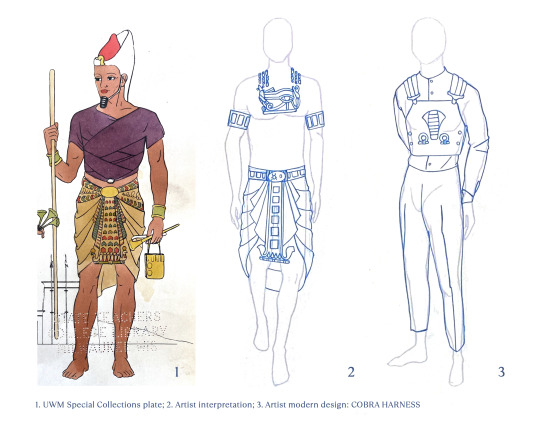
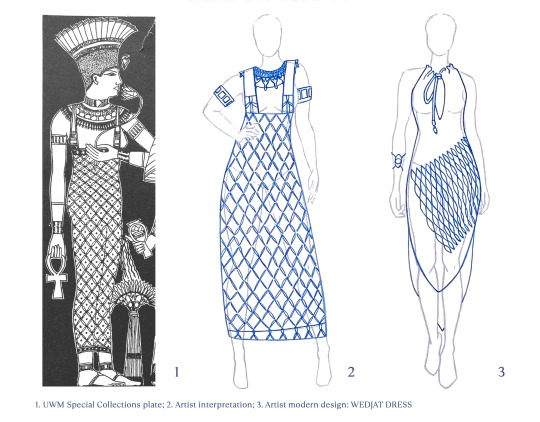
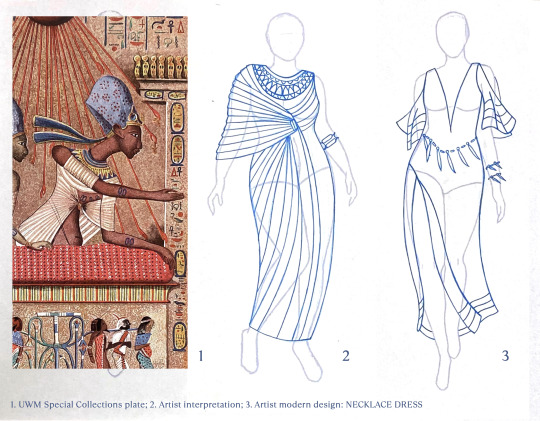





Fashion Friday: Beer, Beef and Poultry
I am an MFA graduate student in Intermedia Arts and I’m conducting an independent study in Special Collections this semester on the history of costume and fashion to help inform my own practice. So, welcome to my first #Fashion Friday post on a historical compendium of costume through the ages! This spring 2022 exploration will include my original drawings of interpretations from the UWM Special Collections' holdings of historical fashion and costume publications and then my own modern designs where the spirit of the historic retrospective is manifested.
Ancient Egypt is our starting point today where diagonals, pleats, and iconography abound. Much of our knowledge of this sophisticated civilization originates from preserved remains of pharaohs that have been excavated from cemeteries and tombs.
We find that costume silhouetting is long and tight for women while men wear aprons or skirts, often with their chest exposed. Accessories are the epitome of ornament where animals and gods give way to the beauty of the Egyptian faience—a brilliantly colored glaze of lime, clay, and sand. Shown here are my inspirations and my designs:
1.) "Egyptian Old Kingdom" plate from Costumes of the World, 100 Hand Colored Plates from Ancient Egypt to the Gay Nineties, published by the Works Progress Administration, Pittsburgh, Pennsylvania unit, ca. 1940.
2.) Figure from "Egyptian Old Kingdom" plate with my interpretation and inspired design.
3.) My interpretation of and contemporary design inspired by a detail from the "Ancient Egyptian Costume" plate in A Short Description of Historic Fashion published in New York by the Columbia University Teachers College Bureau of Publications in 1925.
4.) My interpretation of and contemporary design inspired by a detail from the "El Amarna" plate in The Coloured Ornament of All Historical Styles published in Leipzig by Baumgärtner in 1915.
5-7.) Plates from volume one of Gli Stili Nella Forma e nel Colore, Rassegna dell' Arte Antica e Moderna di Tutti i Paesi published in Torino by C. Crudo & Co. in 1925.
8-9.) My own interpretations of Egyptian iconography and deity representations.
Burial customs of these generations 4,000 years ago sustains a universal belief of ka or vital essence, which the Egyptians believed was sustained through food and drink. Hence, the title of this entry as Beer, Beef and Poultry, which was inscribed as part of a petition on the stela (monument) for the venerated Nit-ptah, the son of Egypt's 18th-dynasty pharaoh whose tomb was later shared by the infamous King Tutankhamun (a/k/a King Tut).The petition is a humble request to the gods that the pharaoh's son would endure everlasting life with the sustenance of Brew City.
View more posts from Costumes of the World.
View more posts from The Coloured Ornament of All Historical Styles.
View more posts from Gli Stili.
View more Fashion Friday posts.
—Christine Westrich, MFA Graduate Student in Intermedia Arts
#The Coloured Ornament of All Historical Styles#Pennsylvania’s Museum Extension Project#Gli stili nella forma e nel colore rassegna dell’ arte antica e moderna di tutti i paesi#A Short Description of Historic Fashion#fashion friday#graduate research#ancient Egyptian fashion#Egyptian fashion#costume design#fashions#costume#historical costumes#Christine Westrich
192 notes
·
View notes
Photo


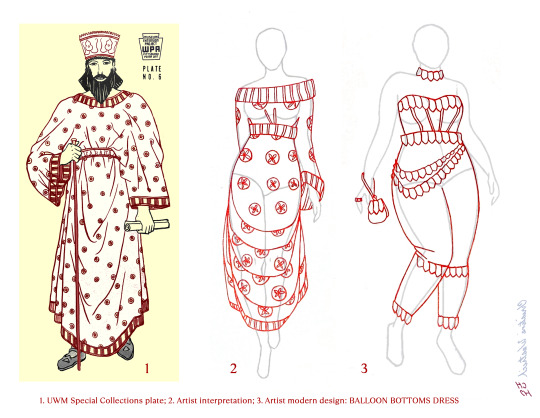

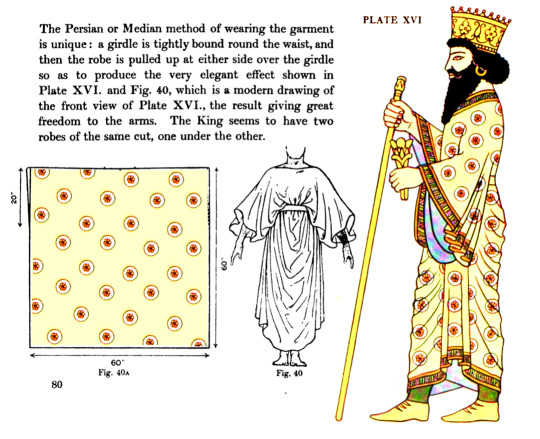
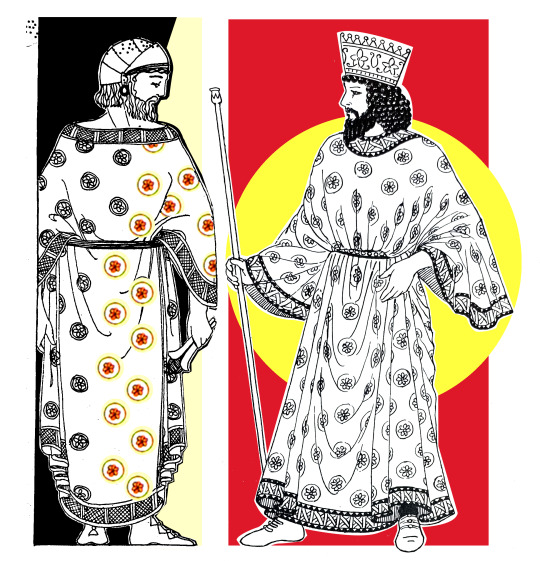




Decorative Sunday: Parisian, I mean, Persian Posh
This my third post exploring UWM Special Collections for fashion favorites, this time adding the vibrant, yet often assimilated world of the Persian Empire to my practice. The empire begins around 550 BCE with an ambiguous discernment of costume, blending Babylonian, Assyrian and Chaldean dress.
Blended customs are revealed in the recoveries at ancient ruins in the Zagros Mountains (modern-day Iran), sites that are currently protected by the UNESCO World Heritage Convention (Pasargadae, Persepolis, and Susa). And while mingled, the excavations provide today's most prominent testimony of Persian tradition. I'm certainly not the first to dig into these digs as this post's lead image is inspired by the archaeological site in Susa showing old-world Persian costumes reinvented for the modern Parisian flapper by a French illustrator in 1926.
The Persian region has a long presence in antiquity, spanning thousands of years (e.g. Susa, with continual habitation dating back 9000 years), with destroyed fortresses and sacked empires still buried and awaiting discovery. Over the millennia, violence and the hunt had a continual presence, and wardrobes were often waisted to accommodate piercing and slicing blades.
The rewards of military and bestial campaigns included sumptuous accessories at court such as silk umbrellas and cotton robes, but also the expansion of Persian influence with wardrobe copycats in foreign lands.
My own fashion plates are inspired by such warrior spoils. Some are obvious and some less so, such as four hand-held fronds and three waist-worn weapons—can you find this posh?
Here is a listing of sources for my designs and featured plates from both Special Collections and the library’s general collection, which I have augmented with color and outline to emphasize the details of my inspiration:
1) Persian fashion for Parisian couture, from L'hisoire du costume feminin ondial: de l'an 5318 avant J.C. a nos jours, published in Paris, circa 1926.
2) My interpretation of and contemporary design for the UNDER THE UMBRELLA dress inspired by Figures 2 and 3 in Plate 18 in Geschichte des Kostums, published in New York by E. Weyhe, circa 1905.
3) My interpretation of and contemporary design for the BALLOON BOTTOM dress inspired by Plate 6, "Persian", in Costumes of the World, 100 Hand Colored Plates from Ancient Egypt to the Gay Nineties, published by the Work Projects Administration in Pittsburgh, 1940.
4) My interpretation of and contemporary design for the SQUARE SET dress inspired by Figure 11.10, "Persian Man with Walking Stick", in Costume: An Illustrated Survey from Ancient Times to the Twentieth Century, published by Plays Inc. in Boston, 1968.
5) Figure and tunic design from Plate XVI in Ancient Egyptian, Assyrian, and Persian Costumes and Decorations published in England by A. & C. Black in 1920, available online in the UWM Libraries General Collection.
6) Left figure from A Short Description of Historic Fashion published in New York by the Columbia University Teachers College Bureau of Publications in 1925. Right figure from Costume: An Illustrated Survey from Ancient Times to the Twentieth Century, published by Plays Inc. in Boston, 1968.
7, 8) Plates from volume one of Gli Stili Nella Forma e nel Colore, Rassegna dell’ Arte Antica e Moderna di Tutti i Paesi published in Torino by C. Crudo & Co. in 1925.
9, 10) Plates 18 and 48 from in Geschichte des Kostums, published in New York by E. Weyhe, circa 1905.
The last image is an ode to the dominant Persian religion of Zoroastrianism, a belief system rooted in the duality of light and dark, with fire temples encouraging light and goodness in thoughts, words, and deeds. Dating nearly 4,000 years ago, this faith survives today, and may have influenced many other philosophies and belief systems, including the Islamic mystical practices of Sufism. If you're looking to express your inner-sun and the fashion plates herein aren't your streetwear, consider these.
View my other posts on historical fashion research in Special Collections.
View more posts from Geschichte des Kostums.
View other posts from A Short Description of Historic Fashion.
View more posts from Costumes of the World.
View more posts from Gli Stili.
View more Decorative Sunday posts.
View more Fashion posts.
—Christine Westrich, MFA Graduate Student in Intermedia Arts
#Decorative Sunday#decorative arts#decorative plates#fashion#fashion plates#fashion friday#persian empire#persian fashion#persian costume#costume design#Christine Westrich#L'hisoire du costume feminin ondial#Geschichte des Kostums#A Short Description of Historic Fashion#Costumes of the World#Gli Stili Nella Forma e nel Colore Rassegna dell’ Arte Antica e Moderna di Tutti i Paesi
111 notes
·
View notes
Photo


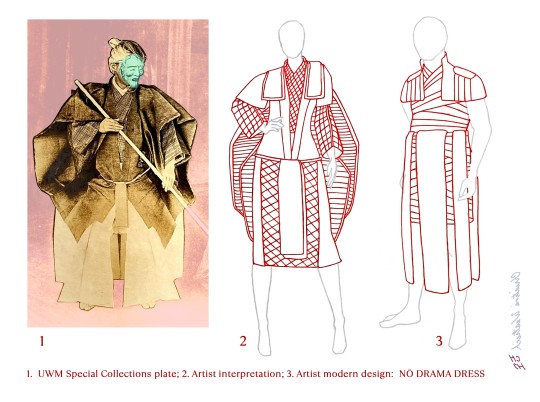
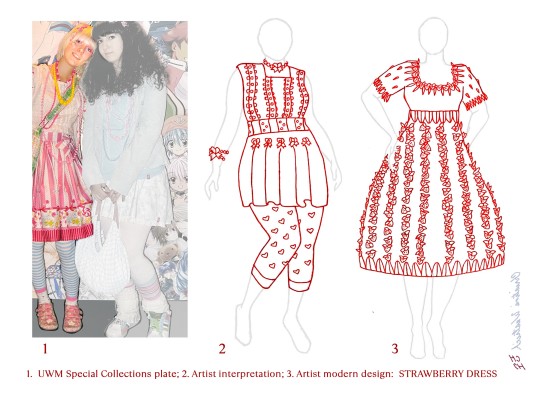


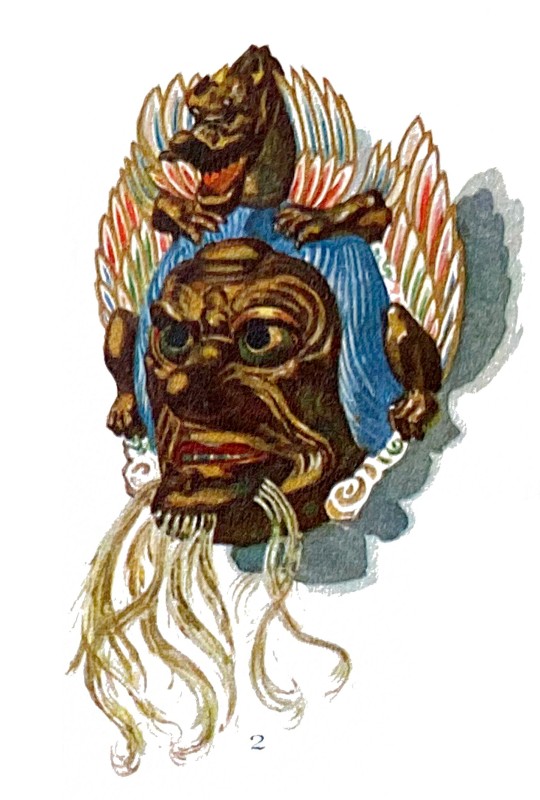

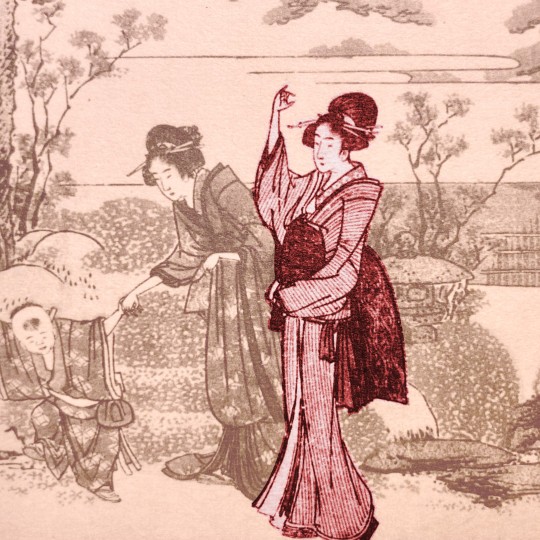
Fashion Friday: Japanese Costume Play
This is my sixth posting on fashion finds in UWM Special Collections, looking forward to a feature on Pompeii civilization next week. Here, you'll find fashion tidbits on Japanese costume.
The fourteenth century of Japanese history marks the formative era of the Nō-gaku, or Nō-dance, lyrical drama productions. Costume served as a metaphor for the varied narratives, predominantly tales of heroes with Buddhist priest teachings intertwined. We witness elaborate textile folds in the costumes, demonstrating layers of wisdom while the rectilinear shaping of the garments pose a simplistic and dignified oeuvre.
Drama staging was austere with emphasis on the male actors who often wore carved wooden masks while reciting Nō poetry in chants honoring Buddhist ancestors. These disciplined performers were highly scrutinized as their prescribed techniques captured soft lighting in the folds of their dress to reveal intensified and vivid colors.
Rigid regulations were also placed on the dress of Japanese court women who wore four layered robes known as junihitoye. Purple silk or a bright scarlet fabric were worn outer-most as the uwagi robe, distinguishing their nobility through fashion.
Such costume play has modernized into anime street fashion and magna pop culture known as Cosplay for the animated film or comic book character that is being mimicked. Masks and facial adornments include latex eartips, plastic gems, plush candies, and all things glitter to express magical energy.
Clothing is elevated as identity in both ancient and contemporary Japanese culture. It is a mechanism by which we can express our political ideologies, religious beliefs, and purported superpowers of an endeared Pokémon. The American historian Anne Hollander considers this in her twentieth century writings, that our fashion choices intend to satisfy an internal image of ourselves.
My first fashion plate is titled "Dragon Dress," highlighting just one design of the layered mantles on the Japanese model. The remaining designs are similarly inspired; can you spot these single inspirations?
Here is a listing of sources from the UWM Special Collections and the UWM American Geographical Society Library, which I have augmented with digital color and outline to emphasize particular details of my inspiration:
1) Photograph of an actor with wooden mask in the Nō-dance Fuji Taiko, from Japanese Theatrical Costumes Worn in the Nō Drama, published in Boston by the Museum of Fine Arts, Department of Chinese and Japanese Art, c. 1900.
2, 5, 7) My interpretation and contemporary design of the Dragon Dress inspired by Plate XXXI (image 2, 7; image 5 is Plate XXXIV), Giapponese, from volume one of Gli Stili Nella Forma e nel Colore, Rassegna dell’ Arte Antica e Moderna di Tutti i Paesi, published in Torino by C. Crudo & Co. in 1925.
3) My interpretation and contemporary design of the Nō Drama Dress inspired by a photograph of a masked actor in the Nō-dance Takasago from Japanese Theatrical Costumes Worn in the Nō Drama, published in Boston by the Museum of Fine Arts, Department of Chinese and Japanese Art, c. 1900.
4, 6) My interpretation and contemporary design of the Strawberry Dress inspired by teenagers dressed in Cosplay (costume play), Magna, and Anime at the Frankfurt Book Fair in Mirror, published in San Francisco by DanaDanaDana Limited Editions, 2010.
8) Photo illustration of a woodcut by Yanagawa Shigenobu of a court lady from Japanese Costume, published in Chicago by the Field Museum of Natural History, 1923; and, Belle Northrup's drawing of Japanese fashion in Plate XVIII, Costume of China and Japan, in A Short Description of Historic Fashion, published in New York by the Columbia University Teachers College Bureau of Publications, 1925.
9) a Hokusai woodcut of a women with child and attendants in Japanese Costume, published in Chicago by the Field Museum of Natural History, 1923.
View my other posts on historical fashion research in Special Collections.
View more Fashion Friday posts.
—Christine Westrich, MFA Graduate Student in Intermedia Arts
#Fashion Friday#graduate research#Christine Westrich#fashion#costumes#Japanese costumes#japanese fashion#fashion design#costume design#fashion plates#cosplay#Nō-gaku#Nō theatre#junihitoye#Anne Hollander
110 notes
·
View notes
Photo







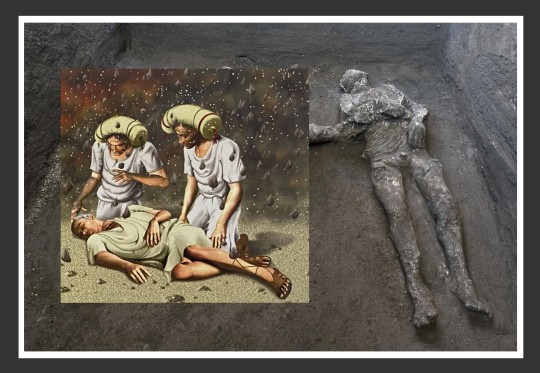


Fashion Friday: Adopt a Pompeiian Dog
For my fashion inspiration this week, I turned to ancient Pompeii, an urban land that succumbed to the eruption of Mount Vesuvius in 79 CE, located on the western coast of Italy, southeast of Naples. The ruins of the city laid buried under ash and earth until 1748 when murals and bodies posed as action figures frozen in time were revealed. While much has been excavatied, today, there are still over 50 acres of land yet to be explored, with growing access to the public as the archeology dig expands.
The allure of Pompeii lies in the catastrophic and immediate deaths of so many who failed to escape, becoming concrete mummies in situ. Recent discoveries in a nearby villa have shown scholars that life in Pompeii was not to be envied, with slavery paramount and social welfare nonexistent.
In spite of the tough Pompeii society, the urban streets were very multi-cultural where theatre was performed in Greek. Street vendors and food stalls provided Roman urbanites with stews of sheep, snail, and fish. Graffiti was found everywhere. Inside one food stall is the mural of a chained dog, with graffiti scrawled on the mural’s painted frame, blaspheming a snack bar owner.
Carnal proclivities were not uncommon in ancient Pompeii. For instance, an excavated fresco of the Spartan queen Leda hints at the everyday homage to the eroticism of mythology. In this story, Leda is seduced and raped by Zeus in swan-form bearing heirs whose power continued the deity tradition of wickedness.
Fortunately, today's leaders of the Great Pompeii Project are using $137 million of EU funds to reach a vast audience, including Instagram and Twitter followers. Prior to this joint effort, the ruins of Pompeii suffered from environmental overexposure, looting, and Italian red-tape while being nestled in a region of organized crime. In fact, packs of stray Pompeiian dogs are now available for adoption as the archeological site leads modern conservationism efforts by abating tourism blight and corruption traps.
My first fashion plate is titled "Dog Paws Dress," highlighting the round velvet foot-pads of our furry friends. The remaining designs are similarly inspired; can you spot these single inspirations?
Here is a listing of sources from the UWM Special Collections and the New York Times, which I have augmented with digital color and outline to emphasize particular details of my inspiration:
1, 3, 4, 8). Photographs of ancient Pompeii frescoes and two Roman bodies, published by The New York Times, written by Elisabetta Povoledo, 2018 - 2020. Images 3 an 4 inspired my own designs for the Swan Wrap Dress and the Curly Rooster Dress.
2, 8). My interpretation and contemporary design of the Dog Paws Dress inspired by David Hawcock's pop-up book, The Pompeii Pop-Up, published by Universe Publishing in 2007.
5) Costume illustration of Roman warriors with animal predator as hooded cloak, in Geschichte des Kostums, published by E. Weyhe in 1923.
6) Woodcut prints by the illustrator Kurt Craemer as published in The Last Days of Pompeii by the Limited Editions Club in 1956.
7) Works Projects Administration illustration of Roman warriors as published in the Costumes of the World, 100 Hand Colored Plates from Ancient Egypt to the Gay Nineties in 1940.
9) Jewelry of the Roman civilization with several animal motifs in Alexander Speltz's plate collection, The Coloured Ornament of All Historical Styles, Part I: Antiquity, published by Baumgärtner in 1915.
10) Ornamentation of Roman aesthetic as seen in Giulio Ferrari's Volume 1: Gli Stili Nella Forma e nel Colore, Rassegna dell' arte antica e Moderna di Tutti i Paesi, published by C. Crudo & Co. in 1925.
View my other posts on historical fashion research in Special Collections.
View more Fashion posts.
—Christine Westrich, MFA Graduate Student in Intermedia Arts
#Fashion Friday#graduate research#Christine Westrich#Roman costumes#Roman fashion#Pompeii#Pompeiian archaeology#fashion#costumes#fashion design#fashion plates#costume design#The Pompeii Pop-Up#Geschichte des Kostums#Costumes of the World#The Coloured Ornament of All Historical Styles#The Last Days of Pompeii
66 notes
·
View notes
Photo

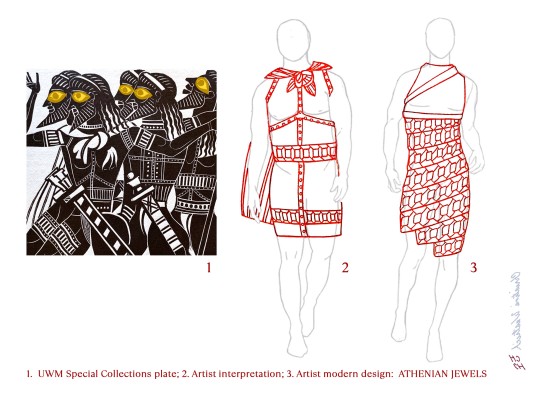

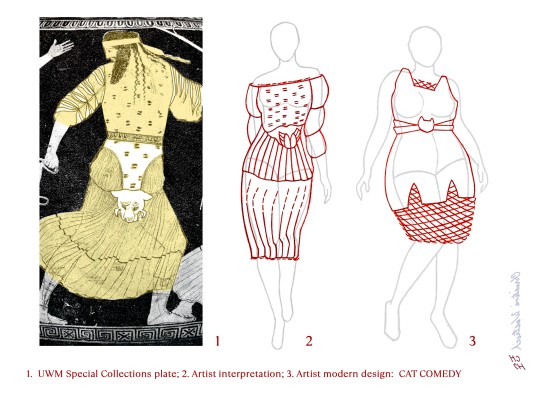





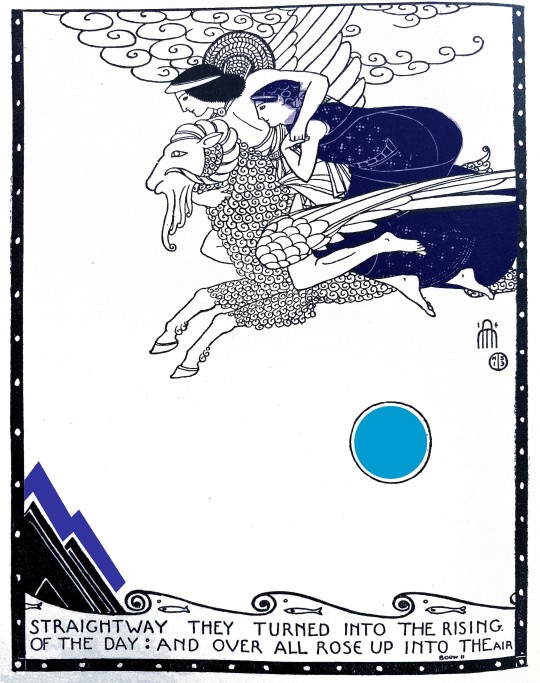
Fashion Friday: For the Love of a Dog
This is my fourth posting on fashion finds in the UWM Special Collections, this time seeking the influence of Greek history and costume on my art and design practice.
The snail-like tendrils of the Greek minor goddess Circe dominate my first image, and it is no mistake that the illustrator, English artist Maxwell Armfield, has depicted them as a curling ruddy gold, since these features became a metaphor of the prized Golden Fleece symbolizing an age of handiwork and fundamental craftsmanship in the eyes of the author, William Morris, in Special Collections’ 1917 copy of The Life and Death of Jason, a Metrical Romance.
This Victorian poem of Jason and the Argonauts, originally published in 1871, has taken extensive liberty with original Greek mythology, an Arts and Crafts manifesto to the power of natural dyes and the mark of the human hand. Further appreciation for such work is seen in Special Collections' 1969 Limited Edition Club copy of Xenophon's Anabasis, with graphic woodcuts by Greek artist Anastasios Tassos, whose angular and exaggerated features translate to the disciplined and dire plight of the brave Greek soldiers.
And while Xenophon was a wartime mercenary, his Greek compatriot, Aristophanes, was the playwright of satiric comedy. Both ancient men followed the teachings of Socrates, one as protege, the other as ridiculer. The Old Comedy style of the latter was steeped in satire and accompanied with phantastic costumes with overstuffed genitals, giving way to distorted theatrical gestures.
The amphora or two-handled Greek pottery herein depicts such costuming in the human-horse-knights, a classic example of the clay vase serving as documentation of ancient lifestyles. While these vessels were widely used for foodstuffs, wine, and wealthy bragging rights, they also served to house the dead. A recent Mykonos excavation in 1961 revealed such pithoi where the jars were recycled for burials, comingling families, and in one case a dog.
My first fashion plate is titled "Athenian Jewels" after the marquis jewel-like eyes so prominent in Greek art; I translate these to the emerald-cut design in the first plate. Can you find the inspiration of waves and cats in the other two?
Here is a listing of sources for my designs and featured plates from both Special Collections and the library’s general collection, which I have augmented with color and outline to emphasize the details of my inspiration:
1 & 10.) Greek characters in William Morris' The Life and Death of Jason, a Metrical Romance, originally published in 1871 and later published in New York, by Dodd, Mead and Company, 1917.
2 & 3.) My interpretations and contemporary designs of the ATHENIAN JEWELS and GREEK WAVES dress inspired by A. Tassos woodcuts in The Anabasis, printed in Athens by Aspioti-Elka Graphic Arts Inc. for the Limited Editions Club (LEC) of New York in 1969.
4.) My interpretation and contemporary designs of the CAT COMEDY dress inspired by Laura M. Stone’s dissertation Costume in Aristophanic Comedy, published in New York by Arno Press, 1977.
5.) "Greek Ionic” plate from Costumes of the World, 100 Hand Colored Plates from Ancient Egypt to the Gay Nineties, published by the Works Progress Administration, Pittsburgh, Pennsylvania unit, ca. 1940.
6.) Warrior woodcuts by A. Tassos in the LEC Anabasis.
7.) Opposing Greek archers in (left) Costume in Aristophanic Comedy and, (right) The Anabasis.
8.) Amphora painting of actors of Greek comedy from Costume in Aristophanic Comedy.
9.) Plate 23, "Vasentypen", in The Coloured Ornament of All Historical Styles published in Leipzig by Baumgärtner in 1915.
View my other posts on historical fashion research in Special Collections.
View more posts from The Anabasis.
View more posts from Costumes of the World.
View more posts on The Coloured Ornament of All Historical Styles.
View more Fashion Friday posts.
—Christine Westrich, MFA Graduate Student in Intermedia Arts
#Fashion Friday#fashons#costumes#historical costumes#Greek costumes#graduate research#Christine Westrich#Maxwell Armfield#The Life and Death of Jason#Anastasios Tassos#The Anabasis#fashion design#fashion plates#costume design#historical fashion#Costumes of the World#The Coloured Ornament of All Historical Styles
77 notes
·
View notes
Photo
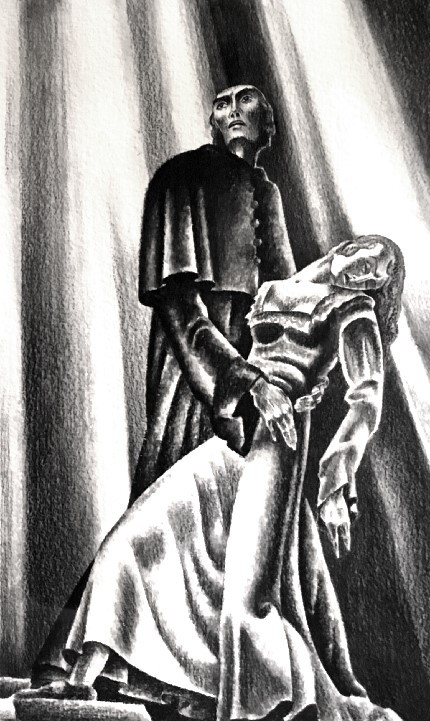






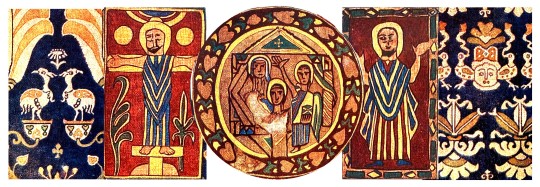


Decorative Sunday Fashion: The Menagerie of the Middle Ages
The Middle Ages are often viewed as the Dark Ages for want of enlightenment and with the Black Death bookending its perilous time. Yet a closer look shows the most novice scholar that the one-thousand-year period from the 5th century to the 15th century is rich with new kingdoms and hybrid cultures.
The Eastern Mediterranean hosted the Roman Empire in its Byzantine lore, while the conquest of the Umayyad Caliphate marched into Northern Africa and Spain, and Western Europe saw the Vikings land on their shores. Civilizations were blended, skilled trades were shared, and manuscripts such as the Divine Comedy abounded.
The Late Middle Ages saw the quick rise and fall of Joan of Arc whose premonitions from the archangel Michael sent her to King Charles VII of France where she became a confidante, military strategist, and gravely feared by the oppressed English rulers. Burned at the stake for heresy and supernatural powers, it was largely a political move to eradicate her power as royal soothsayer.
The ecclesiastical court that judged Joan of Arc may well have been fashioned with mitres just as Roman Catholic leadership was in her modern-era beatification. Original papal tiaras had three tiers representing the authority of sacred orders; silk and linen versions are adorned today and the opulent gold jewels have been shunned and given as symbols to the poor people of the world.
Just as the papal headgear evolved to suit changing sensibilities of society, so too did robewear. The houppelande was worn by both regal men and women of the Middle Ages, and today it is best seen in black on the shoulders of our Supreme Court. The robes were collared in a variety of forms, standing up, V-neck, or perhaps in most recent memory, in the bejeweled style of the dissent collar.
My first fashion plate is titled "Joan of Arc Dress," armor and flames in style. The remaining designs are similarly inspired; perhaps you can trace the muse through each iteration.
Here is a listing of sources from the UWM Special Collections which I have augmented with digital color and outline to emphasize particular details of my inspiration:
1, 10). photogravures by Lynd Ward in a tale of the Middle Ages, The Cloister and the Hearth, published by the Limited Editions Club in 1932.
2). My interpretation and contemporary design of the JOAN OF ARC Dress based on the illustration of Christian dress in the Middle Ages in Adolf Rosenberg's Geschichte des Kostums published by E. Weyhe in 1923.
3). My interpretation and contemporary design of the MITRE Dress based on common dress worn by Hebrew and Christian ecclesiastics, illustrated by Belle Northrup in A Short Description of Historic Fashion published by the Teachers College of Columbia University in 1925.
4, 6). My interpretation and contemporary design of the HOUPPELANDE Dress based on garments of the Middle Age illustrated by Paul Louis de Giafferri in The History of French Masculine Costume published by Foreign Publications in 1927.
5) Byzantine costume plate in the United States Work Projects Administration Museum Extension Project publication, Costumes of the World, 100 Hand Colored Plates from Ancient Egypt to the Gay Nineties, 1940.
7) "Indiano" motifs through the Middle Ages, plate XXXVIII in Gli Stili Nella Forma e nel Colore, Rassegna dell' arte antica e Moderna di Tutti i Paesi, published by Crudo & Co. in 1925.
8) Christian tapestry, plate 57 in Alexander Speltz’s The Coloured Ornament of All Historical Styles, Part I: Antiquity. Leipzig, GE: Baumgärtner, 1915.
9) German expressionist oil painting by Melanie Kent Steinhardt which evokes a common perception of life in the Middle Ages, in The Life and Art of Melanie Kent Steinhardt, published by Rabbit Hill Press in 2002.
View my other posts on historical fashion research in Special Collections.
View more Decorative Sunday posts.
View more Fashion posts.
—Christine Westrich, MFA Graduate Student in Intermedia Arts
#Decorative Sunday#fashion#Middle Ages#Medieval costumes#Christine Westrich#fashion design#costume design#graduate research#decorative arts#fashion plates#The Cloister and the Hearth#Lynd Ward#Geschichte des Kostums#A Short Description of Historic Fashion#The History of French Masculine Costume#Costumes of the World#Gli Stili Nella Forma e nel Colore#The Coloured Ornament of All Historical Styles#The Life and Art of Melanie Kent Steinhardt
35 notes
·
View notes